- Agile Sprint Planning | Everything You Need to Know
- What is Project Management Process ? : A Complete Guide
- What is Lean Management? : A Complete Guide
- What is ITIL ? Know about the Framework
- What is Six Sigma?| Know the tools used
- What is Kanban Training?|Know more about it
- Project Management Tools and Techniques : A Complete Guide
- What is Project Management? Everything You need to Know | Salary for the role
- Srum Org Certification? All you need to know about it
- MS Project Certification | All you need to know
- What is Project Manager? Know about the salary
- Six Sigma Certification Cost | Know all details about it
- Difference Between PMO and Project Manager? | Expert’s Top Picks
- What are Project Management Tools | Its Techniques | Everything You Need to Know
- What is Agile |Its Methodology and Types | How to Implement [ OverView ]
- What is a Product Roadmap? | How to Create one | A Complete Guide with Best Practices
- Scrum vs Kanban | Agile at Scale | New Agile BenchMark
- How to Effectively Manage Stakeholders | A Complete Guide For Beginners with Experts Top Picks
- What is Scaled Agile Framework (SAFe) | The Leading Framework For Business Agility | Everything You Need to Know
- How to Become a Project Manager | A Definitive Guide with Best Practices
- Time Management Tools to Help You Succeed as a Professional | Expert’s Top Picks
- Top 10 Tips for Agile Sprint Planning To Implement Efficient Marketing | Step-By-Step Process with REAL-TIME Examples
- What is ICP-ACC (ICAgile Certified Agile Coaching)? | A Definitive Guide with Best Practices [ OverView ]
- How To Run An Effective Agile Retrospective-Agile management | Everything You Need to Know
- What Skills Does One Acquire After The PMP Certification?
- A Definitive Guide: Most Effective and Proven Time Management Techniques [ OverView ]
- What Gaps I Filled After CSM Certification For my Scrum Project? [ OverView ]
- How to Create A Plan And Manage Your Projects Better?: Step-By-Step Process [ OverView ]
- What is User Story Mapping? : A Complete Guide with Best Practices
- What is Design Thinking ? : Benefits and Special Features | A Definitive Guide with Best Practices
- What is the Capability Maturity Model (CMM) [ For Freshers and Experience ]
- What is Sprint Planning ? | A Definitive Guide | Step-By-Step Process with REAL-TIME Examples
- What is Total Productive Maintenance (TPM) and How Does It Help in Equipment Effectiveness [ OverView ]
- What are Agile Metrics ? : A Complete Guide For Beginners [ OverView ]
- What is Agile Marketing and Why Do You Need It | Step-By-Step Process with REAL-TIME Examples
- Why is Retrospection Needed? : A Complete Guide For Beginners [ OverView ]
- Developing Project Schedule : Role of Float, Leads, and Lags [ OverView ]
- Project Life Cycle vs Product Life Cycle | Know Their Differences and Which Should You Learn?
- Projects in Business Environments | A Complete Guide For Beginners [ OverView ]
- What is Business Agility ? and Why is it Important ? Expert’s Top Picks
- The Most Important Benefits of Blended Learning | A Complete Guide For Beginners
- Can Business Analyst be a Project Manager? : Expert’s Top Picks
- Why A PMO Is Second In Line To A Project Manager ? | Expert’s Top Picks
- Devops vs Waterfall | A Definitive Guide and Which Should You Learn?
- Jira vs Trello | Know Their Differences and Which Should You Learn?
- Key Values and Principles Behind the Agile Manifesto | A Definitive Guide
- What are Scrum Ceremonies : The Ultimate Guide with Expert’s Top Picks
- Business Analyst vs Financial Analyst | Know Their Differences and Which Role is Better ?
- Learn Burndown Charts With Jira : Comprehensive Guide [ For Freshers and Experience ]
- What Is Scrum XP? : Step-By-Step Process with REAL-TIME Examples
- Phases of Project Management | Step-By-Step Process | Expert’s Top Picks
- Project Manager Salary in India – How much does a PM earn? [ Job & Future ]
- Why Do Scrum Masters Get Paid so Much? [For Freshers and Experience]
- What Best Describes a Scrum Team? All you need to know [ OverView ]
- JIRA vs TFS | Differences and Which Should You Learn?
- Anti-patterns of a Scrum Master : Step-By-Step Process
- SCM Tools and Frameworks | A Complete Guide with Best Practices
- Stages of Team Development | Everything You Need to Know
- Project Management Consultant : Job Description, Skills Required | Everything You Need to Know
- CSM vs PSM : Difference You Should Know
- Top Characteristics of a Project Manager : Expert’s Top Picks
- Roles And Responsibilities Of A Product Owner : Everything You Need to Know
- Common Project Risks and How to Tackle Them | Expert’s Top Picks
- Benefits of Having Shorter Sprints in Agile – Everything You Need to Know
- Group Discussion Tips | A Complete Guide with Best Practices
- PMP Certification Cost : All you need to know
- DMAIC Process and Methods | All you need to know [ OverView ]
- Agile Scrum Vs Kanban | Know the difference
- Deming vs Juran vs Crosby
- What is Project Scope Management and Why It’s Important?
- The Basic Principles of Project Management
- Top PMP Exam Questions and Answers for 2020
- Risk Management Strategies
- Roles and Responsibilities of A Scrum Master
- ROM Estimate Vs Definitive Estimate
- Guidelines for Creating and Maintaining a WBS Dictionary
- How to Become a Certified ScrumMaster?
- Top Professional Skills for 2020
- Fast Tracking Vs Crashing
- PMP Vs PRINCE2 Vs CAPM
- PMP Earned Value Management (EVM) And Formulas
- What is Certified Scrum Professional (CSM)?
- Top Leadership Theories Every Manager Should Know
- What is Deliverables in Project Management?
- How To Prepare For TOEFL
- History and evolution of the PMP Certification
- What Is Float In Microsoft Project?
- Rules to set you up for success in project
- What is Scrum Project Management?
- What Is Estimating Activity Duration in Project Management?
- What Are The PMP Terminologies Relating To Cost Knowledge Area?
- What is Project Scope Management processes?
- What Are The Types of Organization In PMP?
- Books to Beat the Scrum Master Certification
- Agile Coach Vs Agile Consultant
- What is the cost of quality in project management?
- Signs Your Career May Be Stagnation and Tips to Overcome Downturn
- Certified ScrumMaster (CSM) Certification
- Lean Six Sigma Black Belt Certification
- What is schedule Activity in project management?
- Why Do We Need a Project Charter?
- PMP Certification Exam Preparation Mind Map
- Why Quality Professionals Should Use Infographics In Project Management?
- Role of Earned Value Technique in Project Management
- What is Project Quality Management?
- Tools and Techniques to Estimate Project Cost
- What is a Project Charter And Project Scope in Project Management?
- Why Should You Conduct Project Status Meetings with Your Team?
- The 7 R’s of Change Management
- What Are The Categories and sources of risk in your project?
- What Is a Network Diagram in Project Management?
- What are The Types of Contracts In PMP?
- Residual Risk Vs Secondary Risk
- Impact of the stakeholders on the projects
- Effort Vs Duration Vs Elapsed Time
- Agile vs Scrum
- What Is Six Sigma Quality Assurance?
- How to Close a Project?
- What Qualifications Do You Need to be a Project Manager?
- Project Management Vs General Operations Management
- Enterprise Environmental Factors & Organizational Process Assets
- What is a project manager?
- Important Questions for PMP Certification Exam
- How is the PMP Exam changing, in 2015 & 2020?
- How To Renew Your PMP Certification?
- The Importance of Having Project Acceptance Criteria in Your Projects
- Tips for PMP Exam Preparation
- What is requirement traceability matrix RTM in Project Management?
- Poor Performance Appraisal? Here are the tips to turn any negative feedback into positive.
- How to build a successful Career in Agile and Scrum?
- Importance of Tuckman ladder model in HR management
- How To Apply For The PMP® Exam In Easy Steps
- How to Write a Six Sigma Problem Statement
- What is a lessons learned document in PMI?
- Perform Quality Assurance Vs Perform Quality Control
- How to Improve Quality Management Consistently?
- Interactive Vs Push Vs Pull Communication
- what is risk management?
- Key Appraisal Questions to Prepare For
- What are the MSP Certifications?
- What Is A Six Sigma Control Plan?
- How to Create a Project Plan in Excel?
- Agile Prioritization Techniques
- Tips to Help Millennials Climb the Corporate Ladder
- What is an Issue Log?
- Advantages of PMP over MBA
- Top Successful Project Estimation Techniques
- PMP Examination Preparation – ITTO’s
- Employee Training Rewards That Actually Improve Learning
- Lean principles
- What Does It Take to Become a Successful Agile Coach
- Projects VS Programs
- The Role of Six Sigma in Manufacturing
- The Top Formulas to Memorize Before Your PMP Exam
- Roadmap to CSM (Certified Scrum Master) Certification
- What are Some Qualities of a Good Manager and Good Leader?
- How to Handle Project Monitoring and Controlling Processes?
- Top Free Agile Tools For Any Project Manager
- Risk Assessment in Project Management
- The Concept of Zero Defects in Quality Management
- The Importance of Work Packages in Project Scope Management
- How to Get Project Management Experience for PMP Certification
- Different Ways to Calculate the Estimate at Completion (EAC)
- What Is a ScrumMaster?
- What is Risk Register?
- Agile Certifications
- Top-down Approach Vs Bottom-up Approach
- Leadership Vs Management
- What is Feasibility Study and Its Importance in Project Management?
- What Is a Project Management Plan?
- The Professional Advantages of the CAPM Certification
- PRINCE2 Vs PMP
- Rita Mulcahy’s PMP Prep and PMBOK® Guide
- What is Project Cycle Management?
- What is Project and Process Metrics?
- PMBOK® Sixth Edition is Here! What Project Managers Should Know?
- CAPM Certification
- Top Project Selection Methods for Project Managers
- Free Float Vs Total Float
- What is Critical Chain Project Management?
- How to Build a Career in Project Management?
- Scrum Master or Product Owner: What Suits You Better?
- Project Documentation and its Importance
- What is Performance Reporting in the Project Management?
- Top Highest Paying Tech Jobs in India
- Agile Sprint Planning | Everything You Need to Know
- What is Project Management Process ? : A Complete Guide
- What is Lean Management? : A Complete Guide
- What is ITIL ? Know about the Framework
- What is Six Sigma?| Know the tools used
- What is Kanban Training?|Know more about it
- Project Management Tools and Techniques : A Complete Guide
- What is Project Management? Everything You need to Know | Salary for the role
- Srum Org Certification? All you need to know about it
- MS Project Certification | All you need to know
- What is Project Manager? Know about the salary
- Six Sigma Certification Cost | Know all details about it
- Difference Between PMO and Project Manager? | Expert’s Top Picks
- What are Project Management Tools | Its Techniques | Everything You Need to Know
- What is Agile |Its Methodology and Types | How to Implement [ OverView ]
- What is a Product Roadmap? | How to Create one | A Complete Guide with Best Practices
- Scrum vs Kanban | Agile at Scale | New Agile BenchMark
- How to Effectively Manage Stakeholders | A Complete Guide For Beginners with Experts Top Picks
- What is Scaled Agile Framework (SAFe) | The Leading Framework For Business Agility | Everything You Need to Know
- How to Become a Project Manager | A Definitive Guide with Best Practices
- Time Management Tools to Help You Succeed as a Professional | Expert’s Top Picks
- Top 10 Tips for Agile Sprint Planning To Implement Efficient Marketing | Step-By-Step Process with REAL-TIME Examples
- What is ICP-ACC (ICAgile Certified Agile Coaching)? | A Definitive Guide with Best Practices [ OverView ]
- How To Run An Effective Agile Retrospective-Agile management | Everything You Need to Know
- What Skills Does One Acquire After The PMP Certification?
- A Definitive Guide: Most Effective and Proven Time Management Techniques [ OverView ]
- What Gaps I Filled After CSM Certification For my Scrum Project? [ OverView ]
- How to Create A Plan And Manage Your Projects Better?: Step-By-Step Process [ OverView ]
- What is User Story Mapping? : A Complete Guide with Best Practices
- What is Design Thinking ? : Benefits and Special Features | A Definitive Guide with Best Practices
- What is the Capability Maturity Model (CMM) [ For Freshers and Experience ]
- What is Sprint Planning ? | A Definitive Guide | Step-By-Step Process with REAL-TIME Examples
- What is Total Productive Maintenance (TPM) and How Does It Help in Equipment Effectiveness [ OverView ]
- What are Agile Metrics ? : A Complete Guide For Beginners [ OverView ]
- What is Agile Marketing and Why Do You Need It | Step-By-Step Process with REAL-TIME Examples
- Why is Retrospection Needed? : A Complete Guide For Beginners [ OverView ]
- Developing Project Schedule : Role of Float, Leads, and Lags [ OverView ]
- Project Life Cycle vs Product Life Cycle | Know Their Differences and Which Should You Learn?
- Projects in Business Environments | A Complete Guide For Beginners [ OverView ]
- What is Business Agility ? and Why is it Important ? Expert’s Top Picks
- The Most Important Benefits of Blended Learning | A Complete Guide For Beginners
- Can Business Analyst be a Project Manager? : Expert’s Top Picks
- Why A PMO Is Second In Line To A Project Manager ? | Expert’s Top Picks
- Devops vs Waterfall | A Definitive Guide and Which Should You Learn?
- Jira vs Trello | Know Their Differences and Which Should You Learn?
- Key Values and Principles Behind the Agile Manifesto | A Definitive Guide
- What are Scrum Ceremonies : The Ultimate Guide with Expert’s Top Picks
- Business Analyst vs Financial Analyst | Know Their Differences and Which Role is Better ?
- Learn Burndown Charts With Jira : Comprehensive Guide [ For Freshers and Experience ]
- What Is Scrum XP? : Step-By-Step Process with REAL-TIME Examples
- Phases of Project Management | Step-By-Step Process | Expert’s Top Picks
- Project Manager Salary in India – How much does a PM earn? [ Job & Future ]
- Why Do Scrum Masters Get Paid so Much? [For Freshers and Experience]
- What Best Describes a Scrum Team? All you need to know [ OverView ]
- JIRA vs TFS | Differences and Which Should You Learn?
- Anti-patterns of a Scrum Master : Step-By-Step Process
- SCM Tools and Frameworks | A Complete Guide with Best Practices
- Stages of Team Development | Everything You Need to Know
- Project Management Consultant : Job Description, Skills Required | Everything You Need to Know
- CSM vs PSM : Difference You Should Know
- Top Characteristics of a Project Manager : Expert’s Top Picks
- Roles And Responsibilities Of A Product Owner : Everything You Need to Know
- Common Project Risks and How to Tackle Them | Expert’s Top Picks
- Benefits of Having Shorter Sprints in Agile – Everything You Need to Know
- Group Discussion Tips | A Complete Guide with Best Practices
- PMP Certification Cost : All you need to know
- DMAIC Process and Methods | All you need to know [ OverView ]
- Agile Scrum Vs Kanban | Know the difference
- Deming vs Juran vs Crosby
- What is Project Scope Management and Why It’s Important?
- The Basic Principles of Project Management
- Top PMP Exam Questions and Answers for 2020
- Risk Management Strategies
- Roles and Responsibilities of A Scrum Master
- ROM Estimate Vs Definitive Estimate
- Guidelines for Creating and Maintaining a WBS Dictionary
- How to Become a Certified ScrumMaster?
- Top Professional Skills for 2020
- Fast Tracking Vs Crashing
- PMP Vs PRINCE2 Vs CAPM
- PMP Earned Value Management (EVM) And Formulas
- What is Certified Scrum Professional (CSM)?
- Top Leadership Theories Every Manager Should Know
- What is Deliverables in Project Management?
- How To Prepare For TOEFL
- History and evolution of the PMP Certification
- What Is Float In Microsoft Project?
- Rules to set you up for success in project
- What is Scrum Project Management?
- What Is Estimating Activity Duration in Project Management?
- What Are The PMP Terminologies Relating To Cost Knowledge Area?
- What is Project Scope Management processes?
- What Are The Types of Organization In PMP?
- Books to Beat the Scrum Master Certification
- Agile Coach Vs Agile Consultant
- What is the cost of quality in project management?
- Signs Your Career May Be Stagnation and Tips to Overcome Downturn
- Certified ScrumMaster (CSM) Certification
- Lean Six Sigma Black Belt Certification
- What is schedule Activity in project management?
- Why Do We Need a Project Charter?
- PMP Certification Exam Preparation Mind Map
- Why Quality Professionals Should Use Infographics In Project Management?
- Role of Earned Value Technique in Project Management
- What is Project Quality Management?
- Tools and Techniques to Estimate Project Cost
- What is a Project Charter And Project Scope in Project Management?
- Why Should You Conduct Project Status Meetings with Your Team?
- The 7 R’s of Change Management
- What Are The Categories and sources of risk in your project?
- What Is a Network Diagram in Project Management?
- What are The Types of Contracts In PMP?
- Residual Risk Vs Secondary Risk
- Impact of the stakeholders on the projects
- Effort Vs Duration Vs Elapsed Time
- Agile vs Scrum
- What Is Six Sigma Quality Assurance?
- How to Close a Project?
- What Qualifications Do You Need to be a Project Manager?
- Project Management Vs General Operations Management
- Enterprise Environmental Factors & Organizational Process Assets
- What is a project manager?
- Important Questions for PMP Certification Exam
- How is the PMP Exam changing, in 2015 & 2020?
- How To Renew Your PMP Certification?
- The Importance of Having Project Acceptance Criteria in Your Projects
- Tips for PMP Exam Preparation
- What is requirement traceability matrix RTM in Project Management?
- Poor Performance Appraisal? Here are the tips to turn any negative feedback into positive.
- How to build a successful Career in Agile and Scrum?
- Importance of Tuckman ladder model in HR management
- How To Apply For The PMP® Exam In Easy Steps
- How to Write a Six Sigma Problem Statement
- What is a lessons learned document in PMI?
- Perform Quality Assurance Vs Perform Quality Control
- How to Improve Quality Management Consistently?
- Interactive Vs Push Vs Pull Communication
- what is risk management?
- Key Appraisal Questions to Prepare For
- What are the MSP Certifications?
- What Is A Six Sigma Control Plan?
- How to Create a Project Plan in Excel?
- Agile Prioritization Techniques
- Tips to Help Millennials Climb the Corporate Ladder
- What is an Issue Log?
- Advantages of PMP over MBA
- Top Successful Project Estimation Techniques
- PMP Examination Preparation – ITTO’s
- Employee Training Rewards That Actually Improve Learning
- Lean principles
- What Does It Take to Become a Successful Agile Coach
- Projects VS Programs
- The Role of Six Sigma in Manufacturing
- The Top Formulas to Memorize Before Your PMP Exam
- Roadmap to CSM (Certified Scrum Master) Certification
- What are Some Qualities of a Good Manager and Good Leader?
- How to Handle Project Monitoring and Controlling Processes?
- Top Free Agile Tools For Any Project Manager
- Risk Assessment in Project Management
- The Concept of Zero Defects in Quality Management
- The Importance of Work Packages in Project Scope Management
- How to Get Project Management Experience for PMP Certification
- Different Ways to Calculate the Estimate at Completion (EAC)
- What Is a ScrumMaster?
- What is Risk Register?
- Agile Certifications
- Top-down Approach Vs Bottom-up Approach
- Leadership Vs Management
- What is Feasibility Study and Its Importance in Project Management?
- What Is a Project Management Plan?
- The Professional Advantages of the CAPM Certification
- PRINCE2 Vs PMP
- Rita Mulcahy’s PMP Prep and PMBOK® Guide
- What is Project Cycle Management?
- What is Project and Process Metrics?
- PMBOK® Sixth Edition is Here! What Project Managers Should Know?
- CAPM Certification
- Top Project Selection Methods for Project Managers
- Free Float Vs Total Float
- What is Critical Chain Project Management?
- How to Build a Career in Project Management?
- Scrum Master or Product Owner: What Suits You Better?
- Project Documentation and its Importance
- What is Performance Reporting in the Project Management?
- Top Highest Paying Tech Jobs in India

What Are The Types of Organization In PMP?
Last updated on 10th Oct 2020, Artciles, Blog, Project Management
Common Types of Organizational Structures in Project Management
An organizational structure is a standard hierarchy of operations. It defines how you can divide, coordinate, and direct groups. More so, it defines the positions and describes the tasks required to achieve an organization’s objectives and vision.
Organizational structures aren’t set in stone and are tweaked as per the organization’s size, needs, and their philosophy.
Types of Organizational Structures

1. Organic or Simple Organization
Subscribe For Free Demo
Error: Contact form not found.
This type of organization is very flexible and able to adapt well to market changes.
This structure is characterized by having few rules, regulations and management layers and a decentralized decision making layout.
The organic organization’s design deals well with a rapidly changing environment. People work side-by-side to communicate quickly and often solve unforeseen problems, issues and requirements.
Here, the project manager has very little or no authority, and may or may not have a designated job role.
2. Line Organization
This is the simplest form of organizational structure commonly adopted by small companies. It has well-defined authority levels in the hierarchical structure. Power flows from the top down to different operational levels or workers.
The hierarchical structure clearly defines authority, responsibility, and accountability at each level.
Due to its simplicity, authority and responsibilities are transparent and easily traceable. Communication is fast and easy because employees get quick feedback and respond fast.
The project manager performs duties based on position or authority in the hierarchy. Some organizations don’t have this position, but when they do, they may have little or nothing to do.
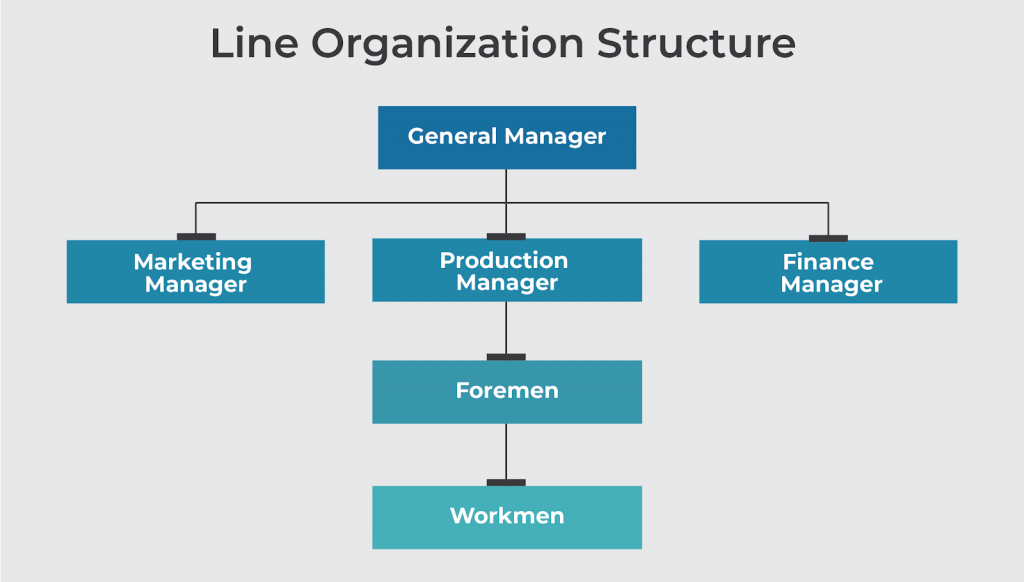
3. Line and Staff Organization
The Line and Staff Organization is a modification of the Line Organization. Here, functional specialists work with line managers to guide and advise them.
This structure is more common in present-day, and most of the larger enterprises adopt this type of set up.
The staff consists of two categories; the general and the specialized team.
General Staff
The general staff consists of the ordinary employees that assist the top management. These staff aren’t experts
Specialized Staff
This team consists of experts that offer services to the organization. Their roles can be advisory, control (as in quality control), or service (such as maintenance).
The Line and Staff Organization uses the expertise of specialists. So the line managers become better in several fields.
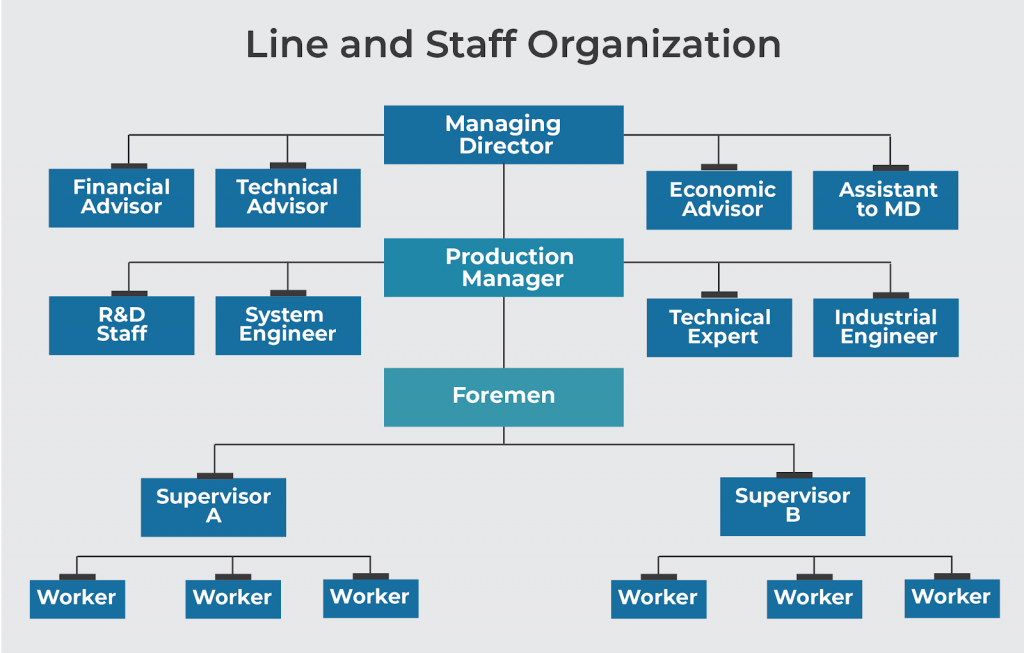
Advantages
- 1. Staff can make quality decisions, get support from specialists, and enjoy better coordination.
- 2. Get training to enhance skills, get an opportunity to work in research & development.
Disadvantages
- 1. Increased confusion and conflicts among the staff
- 2. Higher costs on hiring specialist
- 3. A tendency to develop personal image within the group
4. Functional Organization
The Functional Organization groups workers based on their area of specialization. This structure is an extension of the Line Organization. The functional manager leads the team and manages all the operations or businesses.
The Functional Organization manager enforces directives within a clearly defined scope of authority. This concept originated with Fredrick W. Taylor.
Here you classify workers according to their functional roles and department. Some of the general departments under this are
- Finance
- HR
- Sales
- Customer service
- Supply Chain, etc.,
The organization’s head is the president, followed by the vice president, and the chain goes on. Furthermore, the leaders of departments foresee their departmental performance. So they collectively help the organization control quality and uniformity.
The structure positions departments vertically and disconnected from others. Hence the name “silos.” The department heads manage communication between the top management and his subordinates.
The project manager has a minimal role to play or may not have a designated position. Generally, you’ll play the role of an expediter or work as a coordinator. While as a functional manager, you’ll deal with
- Budget allocation
- Resource allocation, and
- Decision making.
This type of organization is suitable for manufacturing or engineering companies. It supports ongoing operations and practices for producing standard products.
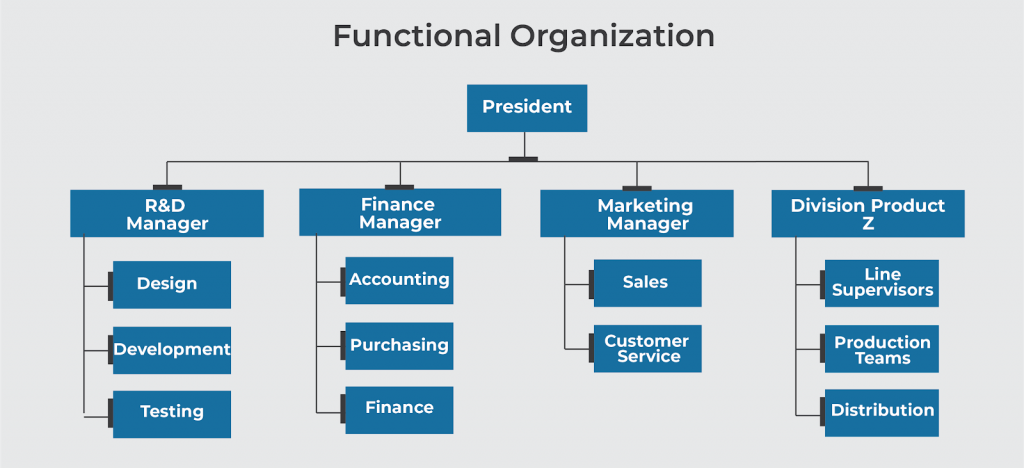
Advantages
Some of the main benefits of this type of organization are:
- 1. It groups employees based on functional skills for a higher degree of performance.
- 2. Employees have experience in the same field, resulting in higher output. Also, they deliver high-quality services and results.
- 3. Accountability is evident, as the roles and responsibilities are clearly defined.
- 4. Hierarchy is visible and no need for multiple reporting
- 5. No duplication of work as each department is different. Also, the job description is clear.
- 6. Career path for the staff is clear and visible
Disadvantages
- 1. Employees get bored from the routine and lose enthusiasm.
- 2. It limits the management skills of functional managers. Hence, they face restrictions on their growth path and remain specialists. So they’re not prepared for top management posts.
- 3. Departments are more concerned with their departmental goals. Hence may be less responsive to the organization’s overall objectives.
- 4. Hiring costs are too high as high-skilled employees cost more.
- 5. It causes conflicts in making critical decisions as a result of bureaucratic hierarchy. Functional managers have full authority and may make arbitrary decisions.
5. Divisional Organization
This type of organization often resembles a Functional Organization. The team members work in different departments. This setup splits the employees into segments based on products, markets, or services.
Functional units that support this structure include:
- Operations,
- Marketing,
- R & D department, and
- Personnel, etc.
This design focuses on service lines like products, customers, area, and time. Since they operate as small organizations, they’re called “self-contained structures.”
So they work independently on divisional goals. But all divisions collectively meet the organizational policies and business objectives.
This type of organization is suitable for companies that
- Operate in different geographical locations,
- Have chain stores with subsidiaries, and
- Banking and insurance business
Here, the project managers may or may not exist or may be hired on temporary assignments.
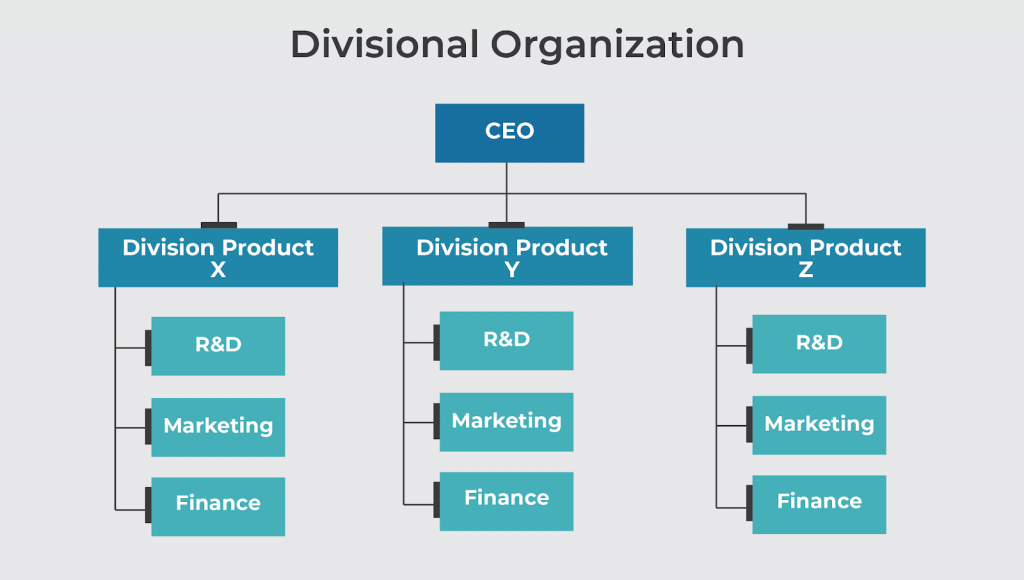
Advantages
- 1. People work in different geographical locations and enjoy different work environments
- 2. Share ideas and enhance skills, thereby creating a collaborative work culture. Thus enhancing overall productivity.
Disadvantages
- 1. This structure affects the integration of the organization as a whole.
- 2. The autonomous nature often results in duplication of functions and resources.
- 3. Segmentation creates boundaries among divisions and may lead to poor inter-unit coordination
6. Project Organization
Project organization is a temporary setup formed for specific projects. It’s also called “projectized organizational structure.” The project manager assigned for the project is the head of this structure.
Once the project is complete, you may choose to dismantle this setup or move it to form a new project. In the case of a new project, the project manager might have to reshuffle the staff to fit the new plan. You’ll hire resources or specialists from different functional departments.
As a project manager, you can use allotted resources until completion and closeout. Albeit you’re accountable for all the activities and timely completion of the project. In other words, you must spend based on the project budget.
The manager assigns clearly defined tasks to each of the team members, along with the complete schedule.
These types of organizations are useful when:
- The project scope is complete, and objectives are clearly defined
- Project is unique and independent
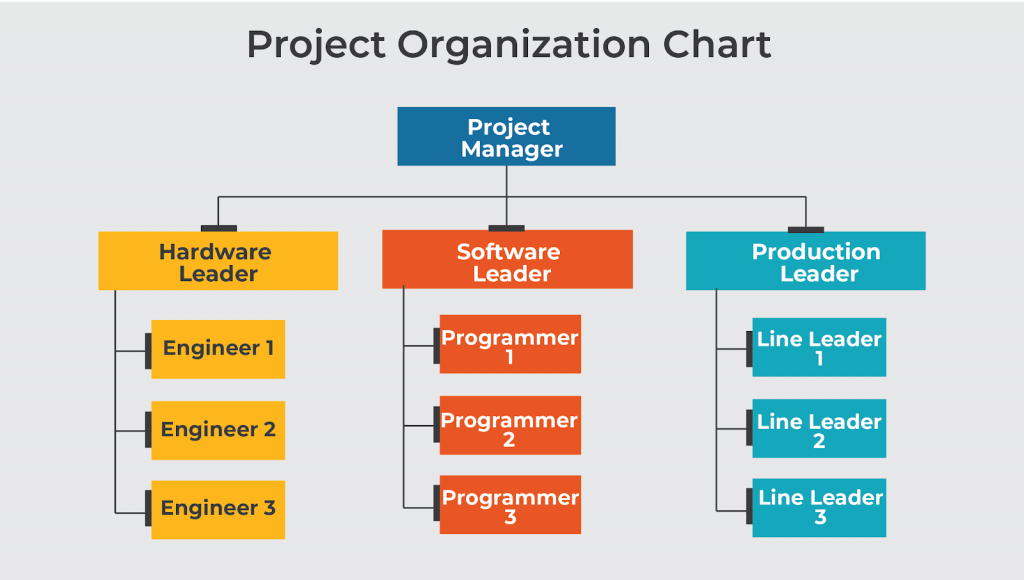
Advantages
- 1. Easy to communicate, hence can stay up to date
- 2. The team can have a strong sense of identity as all are working together to achieve a common goal
- 3. Manage resources efficiently and effectively
Disadvantages
- 1. No clear growth path for the team once the project gets completed
- 2. It’s expensive because the organization dedicates all the specialists for one single project.
7. Matrix Organization
This one is the combination of a projectized and functional organization. This hybrid organization overcomes the limitations of each organization. Here, both the functional and project managers share their respective authorities.
Project managers are generally responsible for
- Overall integration
- Project planning
- Execution of the project, and
- Completion of project activities.
All activities must be done using the assigned resources.
The functional managers are concerned with the operational aspects of the project. They’re also responsible for providing technical guidance.
The functional staff specializes in the skills required for the project. Though project managers manage the project staff, functional managers control the process.
This type of organization is most useful when workers must share available resources. The combination achieves high efficiency and better usage of available resources. Also, they adapt better to the changing trends.
You can further classify the Matrix Organization into
- Balanced
- Strong and
- Weak
The authority level that both functional and project managers share determines its strength.
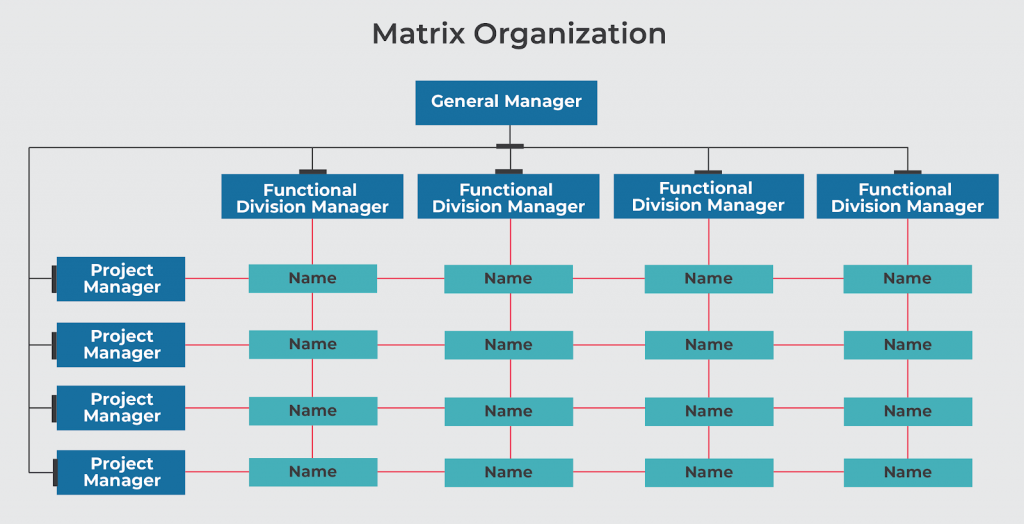
Advantages
- 1. It helps in sharing resources efficiently
- 2. Decision making is balanced and flexible
- 3. Staff members can communicate with each other across boundaries
- 4. Pleasant environment
- 5. It has a clear career graph and job security; hence, members would be more loyal to the organization
Disadvantages
- 1. The dual reporting structure add confusion and results in conflicts
- 2. Create issues when there is no coordination between functional and project managers
- 3. Resources may be under-utilized if you don’t assign them with skill-related tasks
- 4. Costly to maintain as it has many managers
- 5. You need to maintain resources throughout the project, no matter how long it takes
8. Virtual Organization
A virtual organization is a recent development that involves different locations. When your team executes a project in one area, you can manage it from any other place. So you can distribute resources to your project team regardless of location.
You can connect all the locations virtually. The other names for this organizational structure are:
- Digital organization
- Network organization, or
- Modular organization
ICT (Information and Communication Technology) is the backbone of virtual organizations. This organization is a social network without vertical and horizontal boundaries.
Resources aren’t tied to a particular workstation (desk). Also, you can work from any mobile device. You can manage every project activity, including meetings, virtually.
The team reports digitally except on a few occasions that need physical meetings. Hence, it’s common to hear of virtual offices, virtual teams, and virtual leadership
This setup is most suitable for software or IT companies.
Advantages
- 1. Faster and cost-effective as there are no boundaries to work and communication.
- 2. Lower operating costs as no permanent set up required (no need for office premises)
- 3. Have several options like flexitime, part-time work, job-sharing, and home-based working, hence increased
- 4. Employee satisfaction and efficiency
- 5. Can have a larger talent pool
Disadvantages
- 1. No physical contact or communication, thus, lacks team integrity
- 2. Difficult to restrict information sharing as your locations are different
- 3. You have to spread resources across various locations and time zones
- 4. Resources require training for virtual interaction
- 5. Different time zones cause delayed responses
Conclusion
With the different types of organization structures, it’s easy to know what you need. Though each structure has limitations, large and complex organizations adopt the matrix organization.
Line and staff organization has a direct and straightforward hierarchy. Hence it’s used in simple organizations. Software or information technology businesses often adopt virtual organizations.

